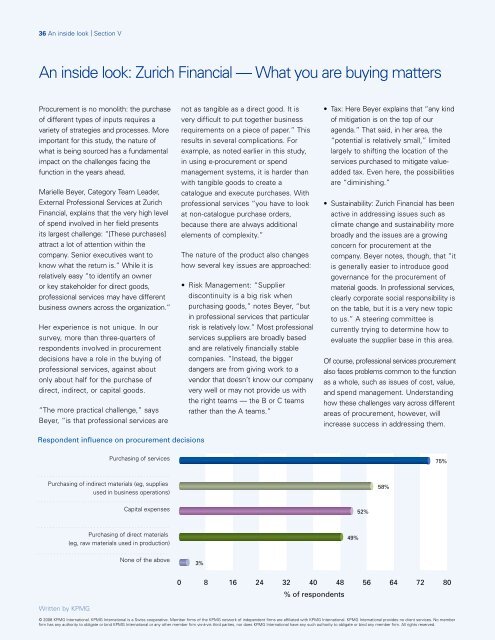Beyond purchasing
You also want an ePaper? Increase the reach of your titles
YUMPU automatically turns print PDFs into web optimized ePapers that Google loves.
36 An inside look | Section V<br />
An inside look: Zurich Financial — What you are buying matters<br />
Procurement is no monolith: the purchase<br />
of different types of inputs requires a<br />
variety of strategies and processes. More<br />
important for this study, the nature of<br />
what is being sourced has a fundamental<br />
impact on the challenges facing the<br />
function in the years ahead.<br />
Marielle Beyer, Category Team Leader,<br />
External Professional Services at Zurich<br />
Financial, explains that the very high level<br />
of spend involved in her field presents<br />
its largest challenge: “[These purchases]<br />
attract a lot of attention within the<br />
company. Senior executives want to<br />
know what the return is.” While it is<br />
relatively easy “to identify an owner<br />
or key stakeholder for direct goods,<br />
professional services may have different<br />
business owners across the organization.”<br />
Her experience is not unique. In our<br />
survey, more than threequarters of<br />
respondents involved in procurement<br />
decisions have a role in the buying of<br />
professional services, against about<br />
only about half for the purchase of<br />
direct, indirect, or capital goods.<br />
“The more practical challenge,” says<br />
Beyer, “is that professional services are<br />
not as tangible as a direct good. It is<br />
very difficult to put together business<br />
requirements on a piece of paper.” This<br />
results in several complications. For<br />
example, as noted earlier in this study,<br />
in using eprocurement or spend<br />
management systems, it is harder than<br />
with tangible goods to create a<br />
catalogue and execute purchases. With<br />
professional services “you have to look<br />
at noncatalogue purchase orders,<br />
because there are always additional<br />
elements of complexity.”<br />
The nature of the product also changes<br />
how several key issues are approached:<br />
• Risk Management: “Supplier<br />
discontinuity is a big risk when<br />
<strong>purchasing</strong> goods,” notes Beyer, “but<br />
in professional services that particular<br />
risk is relatively low.” Most professional<br />
services suppliers are broadly based<br />
and are relatively financially stable<br />
companies. “Instead, the bigger<br />
dangers are from giving work to a<br />
vendor that doesn’t know our company<br />
very well or may not provide us with<br />
the right teams — the B or C teams<br />
rather than the A teams.”<br />
• Tax: Here Beyer explains that “any kind<br />
of mitigation is on the top of our<br />
agenda.” That said, in her area, the<br />
“potential is relatively small,” limited<br />
largely to shifting the location of the<br />
services purchased to mitigate valueadded<br />
tax. Even here, the possibilities<br />
are “diminishing.”<br />
• Sustainability: Zurich Financial has been<br />
active in addressing issues such as<br />
climate change and sustainability more<br />
broadly and the issues are a growing<br />
concern for procurement at the<br />
company. Beyer notes, though, that “it<br />
is generally easier to introduce good<br />
governance for the procurement of<br />
material goods. In professional services,<br />
clearly corporate social responsibility is<br />
on the table, but it is a very new topic<br />
to us.” A steering committee is<br />
currently trying to determine how to<br />
evaluate the supplier base in this area.<br />
Of course, professional services procurement<br />
also faces problems common to the function<br />
as a whole, such as issues of cost, value,<br />
and spend management. Understanding<br />
how these challenges vary across different<br />
areas of procurement, however, will<br />
increase success in addressing them.<br />
Respondent influence on procurement decisions<br />
Purchasing of services<br />
75%<br />
Purchasing of indirect materials (eg, supplies<br />
used in business operations)<br />
58%<br />
Capital expenses 52%<br />
Purchasing of direct materials<br />
(eg, raw materials used in production)<br />
49%<br />
None of the above<br />
3%<br />
0 8 16 24 32 40 48 56 64 72<br />
% of respondents<br />
80<br />
© 2008 KPMG International. KPMG International is a Swiss cooperative. Member firms of the KPMG network of independent firms are affiliated with KPMG International. KPMG International provides no client services. No member<br />
firm has any authority to obligate or bind KPMG International or any other member firm visàvis third parties, nor does KPMG International have any such authority to obligate or bind any member firm. All rights reserved.



